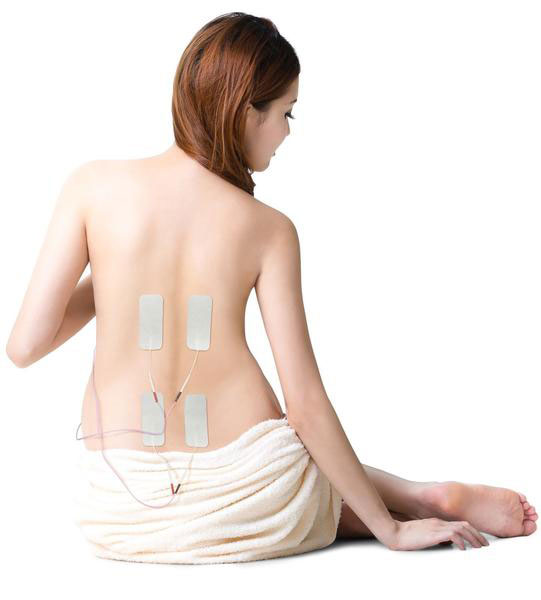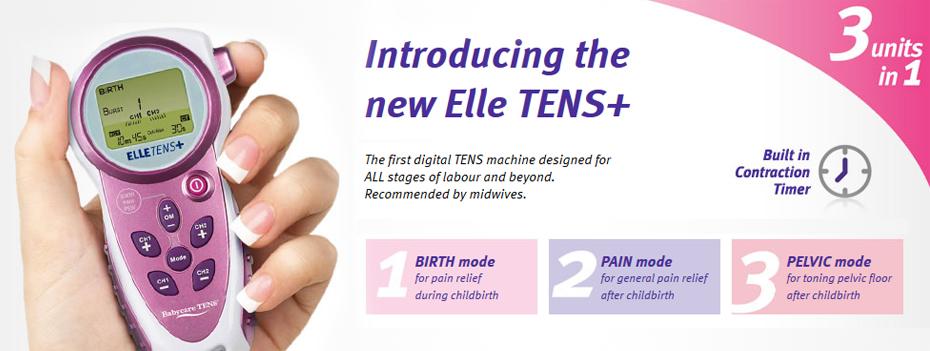TENS during labour
Have you considered TENS during labour to increase your comfort without using medication? Transcutaneous Electrical Nerve Stimulation (TENS) is one of your many pain relief options. It’s non-invasive and doesn’t use medicine – it uses electrical energy. During labour, this is considered safe for you and your baby.
How does it work?
The Machines are small, handheld devices. Sticky pads with small electrodes are placed on your skin (usually your lower back). The electrical impulses feel like a prickling, buzzing or tingling. You get to control the intensity.
So, how does this contraption help you with labour pain? TENS is thought to work in two ways. One is overloading your nervous system and blocking the pain signals before reaching your brain. The other is by triggering your body to release endorphins – your body’s pain relief chemicals.
Is it effective?
Research into how well TENS works in labour has produced varying results. Let’s look at some of those results to answer the question of how well it works. In one of the first studies back in 1977, 44% of the mothers using TENS considered the pain relief to be good or very good. Only 12% said it had no effect.
Other studies, such as a well-designed 1996 study, have not shown a benefit. There was no difference between women receiving TENS or the placebo (“fake” treatment) in the amount of pain medication they requested.
To weigh up the evidence from all the research to date, in 2009, a high-quality review looked at the results of 19 studies on TENS in labour. Reviewers found that “there is only limited evidence that TENS reduces pain in labour, and it does not seem to have any impact (either positive or negative) on other outcomes for mothers or babies…
What do women think of TENS?
But what did the women think? This review found that most women would use TENS again and concluded they should have the choice.
Of course, research didn’t stop there. More recent studies have found it to be helpful. A small 2016 study measured how long it took women who received TENS to ask for an epidural. The participants used it for half an hour. On average, these women then waited five hours longer before asking for an epidural compared to women who didn’t use the machine.
Then, a 2017 study found the machines reduced pain and the length of labour. This time, 90 women were assigned to use either TENS, placebo (TENS machine turned off) or a control group (no TENS). The group using TENS reported less pain during labour and four hours after birth. They also had a shorter first stage of labour (the contractions stage, leading up to the actual birth of your baby).
A third recent randomised controlled trial reported women using the machine were more satisfied with how well it worked than those receiving the placebo.
How can we make sense of the research we have now? There is some evidence TENS can help you cope with discomfort during labour, although it may not work for everyone. And there are no severe side effects for you or your baby.
Most research in labour is carried out at hospitals. How well the machines work at home in the early stages of labour has yet to be well studied. It makes sense that if TENS works in the later, more intense phases of labour, it’s also helpful earlier.
How can you make TENS more effective?
Placing the electrodes at acupressure points can increase your pain relief. You could ask an acupuncturist to show you where to find them. Then, please ensure your partner or support person knows where to put the adhesive pads.
TENS machines can produce low or high-frequency electrical pulses. For example, there are 20 to 100 cycles of electrical impulses per second. Using the machine at a higher frequency provides better results.
TENS works better when you’re active than when you’re lying down. As you may already know, moving around is an effective pain relief strategy and helps the baby move down.
Advantages and downsides of TENS
When you’re exploring your options for labour and birth, please look at the fors and againsts of using TENS during labour. Looking at both sides helps you make an informed choice. Here are some advantages and downsides:
What are the benefits of TENS during labour?
- It’s safe for you and your baby.
- You can keep moving while you use it.
- You are in control of the intensity of the electrical impulses.
- It gives you something to focus on.
- You can choose to combine it with other methods of pain relief.
- It might help you postpone asking for pain medication.
What are the downsides of TENS during labour?
- It may not work for you.
- The tingling or buzzing sensation from the electrical impulses might be uncomfortable (but not painful).
- You can’t use it in the bath, birthing pool or shower.
Do you know when I can use it?
You can start from the first twinges of labour at home. You can usually continue to use it as long as you like. TENS may help you achieve a medication-free birth.
If you don’t feel it helping you immediately, it might be worth persisting for half an hour to an hour. This gives it a chance to stimulate your endorphins.
You might continue to use the machine after your little one arrives. In the days after birth, your uterus continues to produce sharp “afterpains”, especially when breastfeeding. If you have a caesarean birth, you will also have soreness from the operation.
Reference List
Download our PDF document with the references used to create this article.
This page was published on the 24th of January 2024



